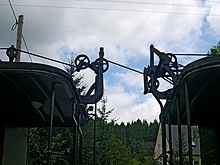Lever brake

The Heberlein brake (according to Jacob Heberlein , patent 1856) is a continuous railway brake that is designed with a mechanical cable actuation. A continuous brake line runs from the locomotive to the last car of the train over the car roofs, through the floor frame on trolleys and generally under the car floors on some railways such as the Spreewaldbahn . There is a reel on the engineer's cab, whereupon the excess length of line is rolled up. In addition to the guide rollers for the brake line, every carriage with a Heberlein brake system has a tiltable combination of two rollers. When the brake line is tensioned, a weight is lifted using this pulley combination and a pull rod. In every car or bogie there is a friction roller on the axle shaft of a wheel set. A chain is attached to the shaft of the corresponding second, loose friction roller, via which the brake in the relevant carriage (or bogie) is applied by the rotary movement. If you let go of the brake line, the weight drops and pulls the loose friction roller against the one that is firmly seated on the axle shaft. The loose friction roller is set in rotation and pulls the brake blocks against the wheels. The force for applying the brake is thus taken from the kinetic energy of the vehicles. To release the brake, you tighten the brake line again, the loose friction rollers are lifted from the fixed ones and the brake is released. If the brake line breaks, all brakes on the train apply. The same thing happens with train separation. This means that the lever brake works automatically. One disadvantage of the lever brake is that it is directional. If the carriages roll back after stopping, the brake is released on them.
Due to its operating principle, the lever arm brake has a greater time delay until the braking effect is achieved than, for example, the compressed air brake or the suction air brake. Therefore, when operating today, it is important to ensure that the traction vehicle and train personnel have had appropriate training and experience. The brake test can only be carried out while moving.
The clearly visible cable guides on the trolleys are typical of the lever brake. To facilitate the formation of the train, there are brake lines in standardized lengths, which are connected by equally standardized hooks. These connecting hooks are designed so that they can run over the guide rollers. Laying the brake line over the roofs and under the car floors is problematic and physically difficult, especially when forming trains and in shunting services.
The lever brake was initially replaced by suction air brakes , then finally by compressed air brakes . During the transition period, locomotives were provided with several controls and wagons with lines for the second braking system. The engine driver had to operate both brakes on trains with mixed brakes. The lever brake was mainly used on narrow-gauge railways. One user with a standard gauge at the end of the 19th century was the Halberstadt-Blankenburg Railway, particularly on the Blankenburg-Tanne cogwheel line at the time .
Due to its functional principle (continuous and automatic), the lever brake is still an approved service brake on the railways, especially at the lower speeds of the narrow-gauge railways.
On some narrow-gauge railways in Saxony, numerous vehicles with the jack-up equipment can be viewed ( Lößnitzgrundbahn , Weißeritztalbahn , Rittersgrün narrow-gauge railway museum ), while the Preßnitztalbahn regularly operates several times a year with the jack-up brake.
The continuous screw wheel brake System Schmid , which prevents the unintentional release of the brakes when rolling back, is similar to the lever arm brake . The Görlitz weight brake is only similar in appearance. With it, the braking force is only applied by the lowering weights without utilizing the kinetic energy of the vehicles.


